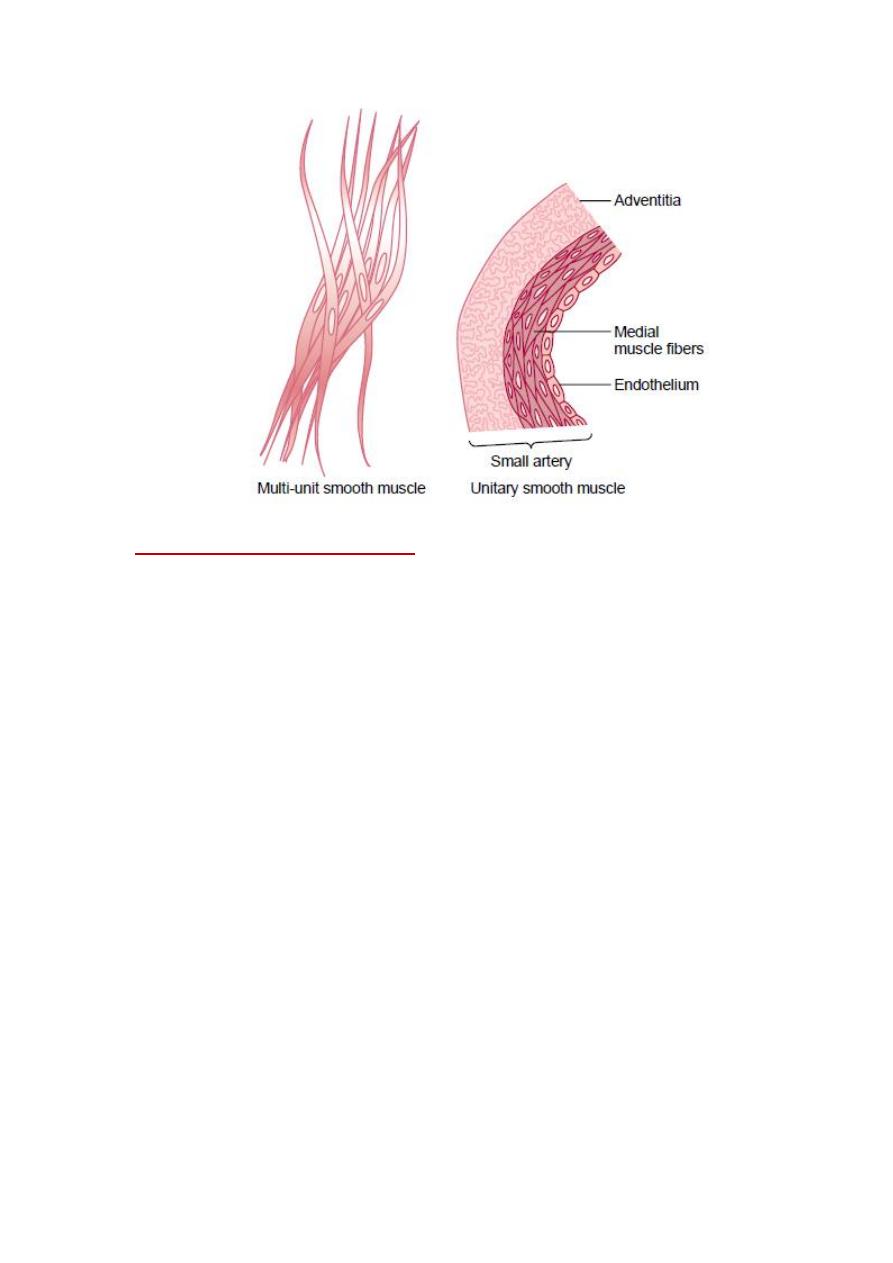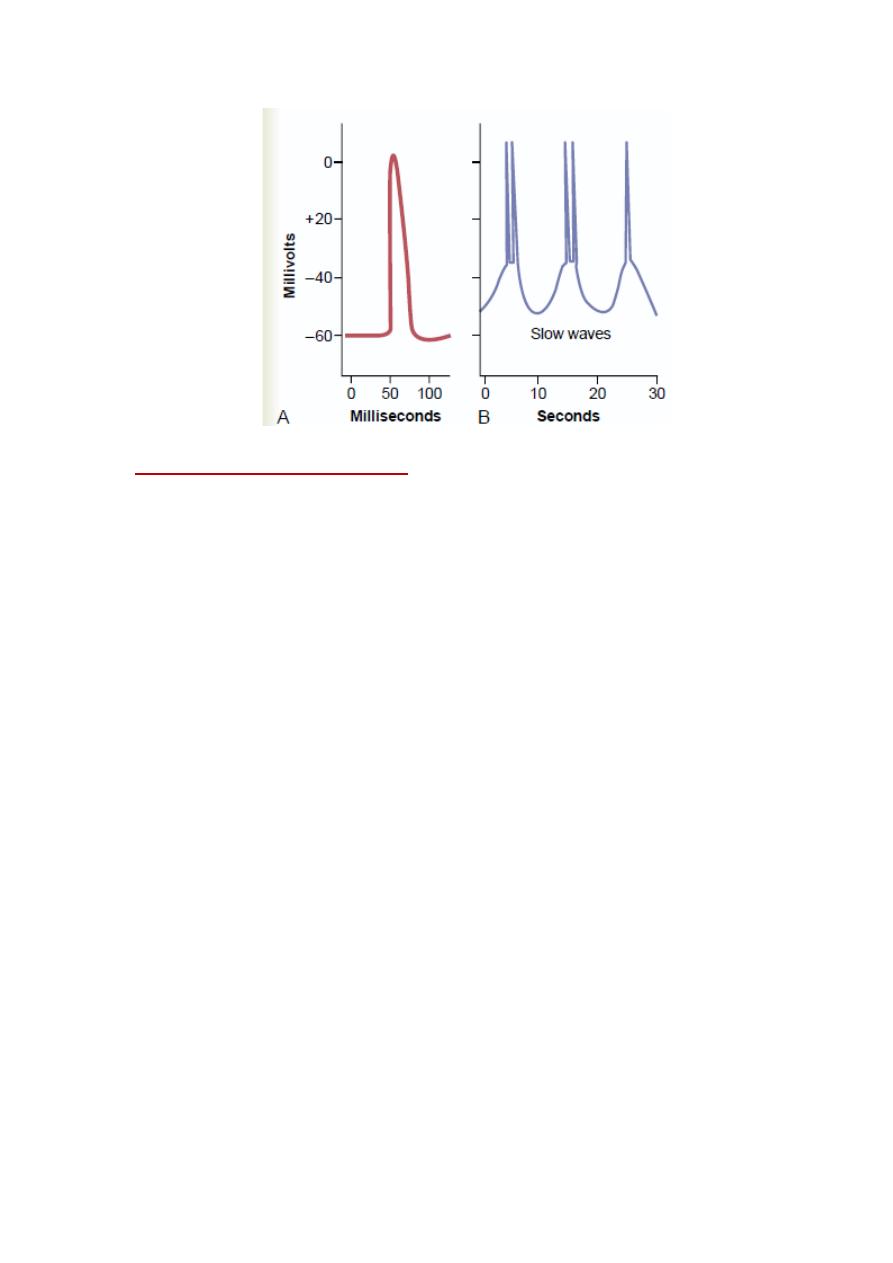
1
Lec 8
Physiology
Dr Hanan Luay
Smooth muscles
Objectives
1-Describe the structural morphology of the smooth muscles and their types?
2-Explain the bases of contraction of smooth muscles?
3-list the factors affecting the smooth muscle contraction?
4- How does changing the length of smooth muscle affect its tension?
Morphology:
1- Lack visible cross striations.
2- Actin and myosin are present.
3- There are dense bodies instead of Z lines.
4- Contain tropomyosin but toponin absent.
5- Poorly developed sarcoplasmic reticulum (
so Ca2 released from this
organelle may account for only the initial phase of smooth muscle
contraction
)
6- Few mitochondria so depend on glycolysis in their metabolism.
Types:
1- Visceral smooth muscle (unitary or single unit).
2- Multi-unit smooth muscle.
Unitary or visceral smooth muscles (or syncytial smooth muscles):
It occurs in large sheets, has low-resistance bridges between individual
muscle cells, and functions in a syncytial fashion, they contract together as a
single unit. It is found primarily in the walls of hollow viscera.
The cell membranes are joined by gap junctions through whom ions can
flow freely from one muscle cell to another.
Multi-unit smooth muscle:
It is made up of individual units without interconnecting bridges. It is found
in structures such as the iris of the eye, in which fine, graded contractions
occur. It is not under voluntary control.

2
Electrical & Mechanical Activity:
Visceral smooth muscle:
It is characterized by the instability of its membrane potential and by the
fact that it shows continuous, irregular contractions that are independent of
its nerve supply.
This maintained state of partial contraction is called tonus or tone.
There is no true "resting" value for the membrane potential, but it averages
about -50 mV, when the muscle active it becomes low and high during
inhibition.
Superimposed on the membrane potential are waves of various types:
These are:
-Slow sine wave-like.
-Sharp spikes.
-Pacemaker potentials.
Thus, In addition to being graded, the excitation-contraction coupling
in visceral smooth muscle is a very slow process compared with that in
skeletal and cardiac muscle, in which the time from initial depolarization to
initiation of contraction is less than 10 ms. The slowness of contraction is
related to the fact that myosin ATPase in smooth muscle is slower in its
action (splitting ATP for the cross-bridge cycle) than it is in striated muscle.

3
Molecular Basis of Contraction;
1-Binding of Ach to Muscarinic reseptors.
2-Ca
2+
influx from the ECF via Ca
2+
channels (the greater the depolarization,
the more Ca2 will enter the cell and the stronger will be the smooth muscle
contraction).
3-Ca
2+
binds to calmodulin, and the resulting complex activates calmodulin-
dependent myosin light chain kinase. This enzyme catalyzes the
phosphorylation of the myosin light chain.
4-The phosphorylation allows the myosin ATPase to be activated, and actin
slides on myosin, producing contraction.
5-Myosin is dephosphorylated by myosin light chain phosphatase in the cell.
6-Relaxation of the smooth muscle.
7- Dephosphorylation of myosin light chain kinase does not necessarily lead
to relaxation of the smooth muscle. a latch bridge mechanism by which
myosin cross-bridges remain attached to actin for some time after the
cytoplasmic Ca
2+
concentration falls. This produces sustained contraction
with little expenditure of energy, which is especially important in vascular
smooth muscle,
and in the walls of hollow organs which must sustain
contractions for long periods of time.

4
Stimulation of the smooth muscles:
1-Stretch:
It contracts when stretched in the absence of any extrinsic innervations.
Stretch is followed by a decline in membrane potential, an increase in the
frequency of spikes and a general increase in tone.
2-Chemical mediators:
Epinephrine or norepinephrine :
The membrane potential usually becomes larger, the spikes decrease in
frequency, and the muscle relaxes
.
Acetylcholin:
Has an effect opposite to that of norepinephrine on the membrane potential
acetylcholine causes the membrane potential to decrease and the spikes
become more frequent, with an increase in tonic tension and the number of
rhythmic contractions.
Released by stimulation of cholinergic nerves (similar to cold and stretch in
vitro).
3- Other chemicals: like progesterone which decreases the activity and
estrogen which increase it (in uterine smooth muscles).
4-Thermal stimuli: like cold which causes spasm.
Function of the Nerve Supply to Smooth Muscle:
It has two important properties: (1) its spontaneous activity in the absence
of nervous stimulation, and
(2) Its sensitivity to chemical agents released from nerves locally or brought
to it in the circulation.
The function of the nerve supply is not to initiate activity in the muscle but
rather to modify it (control).
It has dual nerve supply from 2 divisions of the autonomic nervous system.
Stimulation of one division usually increases smooth muscle activity, whereas
stimulation of the other decreases it.
(i.e if noradrenergic increase ,the Acetylcholine decrease and visa versa).
Relation of Length to Tension; Plasticity:
It is the variability of the tension it exerts at any given length. If a piece of
visceral smooth muscle is stretched, it first exerts increased tension
,
if the

5
muscle is held at the greater length after stretching, the tension gradually
decreases. It is consequently impossible to correlate length and developed
tension accurately.
In intact humans, For example, the tension exerted by the smooth muscle
walls of the bladder can be measured at different degrees of distention as
fluid is infused into the bladder via a catheter Initially there is relatively little
increase in tension as volume is increased, because of the plasticity of the
bladder wall. However, a point is eventually reached at which the bladder
contracts forcefully.
This phenomenon is called stress relaxation and reverse
stress-relaxation. Its importance is that its ability to return to nearly its
original force of contraction seconds or minutes after it has been elongated
or shortened.
Smooth muscles must be able to contract even when greatly stretched—in
the urinary bladder, for example, the smooth muscle cells may be stretched
up to two and a half times their resting length. The smooth muscle cells of
the uterus may be stretched up to eight times their original length by the end
of pregnancy
. Striated muscles, because of their structure, lose their ability
to contract when the sarcomeres are stretched to the point where actin and
myosin no longer overlap.
MULTI-UNIT SMOOTH MUSCLE:
-It is nonsyncytial .
-Contractions do not spread widely through it (discrete, fine and more
localized).
- Very sensitive to circulating chemical substances and is normally activated
by chemical mediators (acetylcholine and norepinephrine)
.
-
Norepinephrine tends to persist in the muscle and to cause repeated firing
of the muscle after a single stimulus rather than a single action potential.
Therefore, the contractile response produced is usually an irregular tetanus
rather than a single twitch.
The simple muscle twitch resembles the twitch contraction of skeletal muscle
except that its duration is ten times longer.
The differences between the three types of the muscles:

6
Cardiac muscles
Smooth muscles
Skeletal muscles
in voluntary
in voluntary
voluntary
The Control
In the heart
In the walls of viscera
Attached to
bones
Site of action
striated
Not striated
striated
Morphology
Cylindrical and
branched
slow
yes
Spindle shaped
Very slow(cross-
bridge heads have
less
ATPase activity than
in skeletal muscle).
Yes for some
smooth muscles
Long cylindrical
Fast -slow
No
cell shape
Speed of
contraction
Capable of
spontaneous
contraction
Excitation or
inhibition
Excitation or
inhibition(modulation
of contraction)
Excitation(contro
l of contraction)
Effect of nerve
stimulation
long
Short
Membrane
refractory
period
single
single
many
Nuclei in each
cell
Connected by
intercalated
Connected by gap
No anatomical or
functional
Connection

7
discs
junctions and bridges
connections
between cells
.
